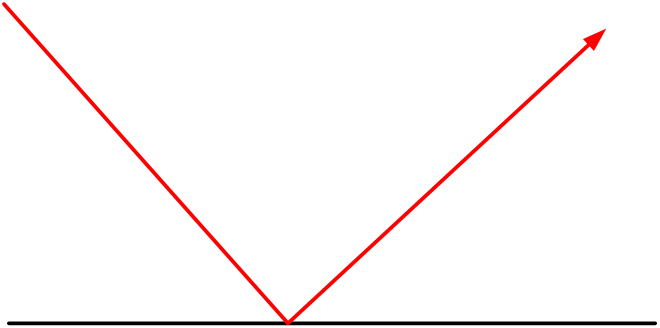In this lecture, we’ll explore three important characteristics of radiofrequency: reflection, attenuation, and absorption. Each plays a critical role in how wireless signals behave and reach their destinations.
Reflection

Let’s start with Reflection. We touched on this briefly in the last lecture, but here we’ll dive deeper. Reflection occurs when a wave hits a surface that is smooth and larger than the wavelength of the wave itself. A useful analogy is to think about how light reflects off a mirror. When light (which is also part of the electromagnetic spectrum) shines onto a mirror, it bounces back, allowing you to see the light in a new direction. Similarly, in wireless networks, when a radiofrequency wave encounters a large, smooth object, like a wall or a building, it reflects in another direction.
To break down the terminology:
- The wave that approaches and hits the object is called the incident wave.
- The wave that bounces off in another direction is known as the reflected wave.
Understanding reflection helps us predict how signals might be redirected in an environment, which can be crucial when designing wireless networks in complex spaces.
Attenuation
Next, let’s discuss Attenuation. Attenuation is the gradual loss of signal strength as a wave travels through an environment. It happens for a few reasons, including distance from the transmitter and obstacles the wave encounters, like walls or furniture.

For instance:
- The further a wave travels from the source, the weaker it becomes.
- Different materials cause different levels of attenuation. For example, a concrete wall will attenuate a signal much more than a glass window.
Attenuation is essential to understand in network design because it helps us plan for signal strength and range. By knowing where attenuation might reduce signal quality, we can adjust transmitter placement or add repeaters to maintain strong coverage.
Absorption
Lastly, let’s cover Absorption. Absorption occurs when a wave encounters a material that absorbs the energy of the wave instead of letting it pass through or reflect. In this case, the signal strength decreases as part of the wave’s energy is absorbed into the material.
Consider this:
- Materials like wood, drywall, and fabric absorb more radiofrequency energy than materials like glass or metal.
- Higher frequencies, such as those in the 5 GHz and 6 GHz ranges, are generally more susceptible to absorption than lower frequencies, like 2.4 GHz.
Absorption is particularly important when planning Wi-Fi networks indoors, as different construction materials in walls and furniture can impact overall coverage and signal quality.
Summary and Key Takeaways
We’ve now covered three characteristics that impact radiofrequency behavior:
- Reflection: When a wave hits a smooth, large object and bounces in a new direction.
- Attenuation: The weakening of a signal as it travels through an environment.
- Absorption: When a wave encounters a material that absorbs its energy, reducing its strength.
These factors are essential to consider when designing a network, as they help determine how far and effectively a signal will reach its intended destination. I hope this lecture helped clarify these radiofrequency characteristics, and I look forward to seeing you in the next one!

0 Comments